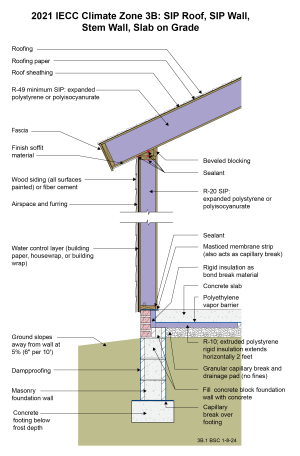Notes
Drawing 3B.1: IECC CZ 3B: SIP Roof, SIP Wall, Stem Wall, Slab on Grade
- This wall and roof assembly is constructed using structural insulated panels (SIPs).
- It is important to seal the interior joints of the SIP roof panels to provide air control layer continuity.
- Many code officials do not count SIPs as continuous insulation when applying Table R402.1.3 of the 2021 IECC. Hence, the R-values shown in the drawing are based on the cavity insulation requirements of this table. However, SIPs walls and roofs typically have much lower framing factors than typical framed walls, resulting in less thermal bridging. For these reasons, it may be most appropriate to use the U-factor table (Table R402.1.2) or the UA alternative (Section R402.1.5) for code compliance rather than using prescriptive R-values. U-factor should account for the thermal bridging of the assembly.
- Note that this assembly does not have an attic (vented or unvented). If the assembly did have an attic space, Section R402.2.1 of the 2021 IECC may apply, depending on the interpretation of the local code official. If so, R-38 could be used over the attic rather than R-49 as long as the R-38 insulation extended over the full width of the exterior wall top plate.
- A drainage plane should be created behind the siding by using a draining housewrap or furring strips. Furring strips only need to create a gap of at least 1/4", so a material such as sill gasket strips installed vertically can be used in place of typical wood furring.
- The function of the masticed membrane strip under the wall bottom plate is to control entry of termites. It must be fully adhered. Some termite control approaches use a strip of stainless-steel mesh embedded in mastic.
- Per 2021 IECC, the under-slab insulation only needs to extend inward 2 feet for Climate Zone 3. However, extending 4 feet may prevent potential comfort issues.
- Portions of the CMU wall may need to be filled solid to meet structural requirements or to accommodate anchor bolts for a sill plate.
- The entire below-grade portions of the stem wall should be coated with dampproofing to control capillary uptake.
